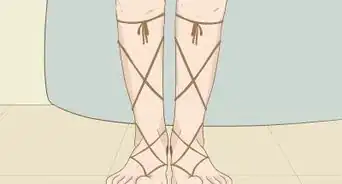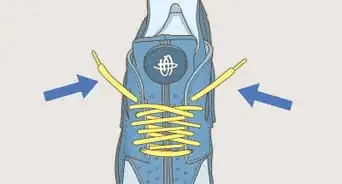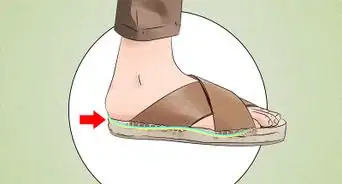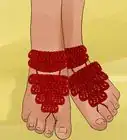This article was co-authored by Hannah Park. Hannah Park is a professional stylist and personal shopper with experience in e-comm styling, celebrity styling and personal styling. She runs an LA-based styling company, The Styling Agent, where she focuses on understanding each individual she works with, and crafting wardrobes according to their needs.
There are 10 references cited in this article, which can be found at the bottom of the page.
This article has been viewed 173,161 times.
Sandals aren't always easy to wear after purchasing them. Choosing the right pair is important, but even a good pair of sandals can feel uncomfortable at first. Breaking in sandals shouldn’t be too difficult, but there are some things you can do to ease the process along. To make sandals more comfortable, choose the right sandal, improve the sandal, and break them in.
Steps
Breaking In Your Sandals
-
1Avoid wearing a brand new pair of sandals for a long walk. Wear your sandals for short intervals of time at first until they're broken in. Otherwise, you risk blisters, cuts, and feeling uncomfortable. You may also experience leg and foot muscle pain if you’re not used to the sandals yet. Try to take it easy for the first few wears.[1]
- The lack of arch support and often the lack of cushioned support in sandals means that sandals are unsuitable to wear for long periods of time. The only exceptions are those built for hiking, but they are made for walking first.
-
2Take short walks in the sandals. Walk around your house and garden to help break them in. Visit the beach and walk on the sand. Then, remove them and go barefoot to give your feet a break. Don’t wear the sandals longer than is comfortable for you.[2]Advertisement
-
3Wear thick socks with your sandals. If your sandals are a bit tight, wear thick socks with them to stretch them out. The look may not be ideal, so you can choose to only wear the sandals with socks around your house. To speed up the process, you can take a blow dryer to the sandals while you are wearing them with thick socks.[3]
- Wool socks are ideal to wear.
-
4Step into a bucket of water. This method only works for leather sandals, but do not do this if your sandals have a cork sole such as Birkenstocks. Step into a bucket of water for a for a few seconds while wearing they sandals until they are wet. Once they are wet, pat the excess water off with a towel to avoid discoloration. Then, wear them while they are still damp. The dampness will allow the shoes to soften and conform to your feet as you wear them.[4]
- If you don’t want to step into a bucket of water, you can use a spray bottle to spritz water onto them.
-
5Try out exercises to prevent foot pain. Sandals that lack support can damage your feet over time. They don’t connect to your foot properly, which causes tension and pressure on your feet and legs. You can prevent this by exercising and strengthening your arch and toes.[5]
- To strengthen your arch, put your foot flat on the floor. Place a penny under the ball of your foot and a pen under your arch. Flex your arch muscle. You should be pushing down on the penny, but not the pen. Keep your toes relaxed. Repeat five times.
- Limber up and strengthen your feet with toe curls. Stand on a towel. Lift your toes and flex your foot. Then, put your foot back on the towel. Curl your toes inwards and try to create space under your arch. Repeat five times on each foot.[6]
Improving the Sandals
-
1Use soap on your sandals. This method will only work for leather sandals. Rub soap around the areas the sandals are likely to rub against your toes, feet, ankles, and heels. This will help to slightly stretch the leather. The soap will also soften the friction between it and your sandals. The best type of soap to use is saddle soap. Apply it with a damp cloth and wipe it off until the shoe is dry.
-
2Wear Band-Aids or moleskins. Put a Band-Aid inside of the sandal in places you think it might rub. Use thick Band-Aids or moleskins. Flimsy Band-Aids will probably peel off throughout the course of the day. Moleskins are usually pretty thick, but be sure to purchase a moleskin with an adhesive.[7]
- You can buy the Band-Aid Friction Block Stick. It is $8 and looks similar to a small stick of deodorant.
-
3Buy arch support. If you feel the lack of arch support, or lack of cushioning is spoiling your experience of walking, add an inner step to the sandal to provide cushioning and support. Special insoles can be purchased that add softness to the insole zone of a sandal. Look for insoles that are cushioned for hard, flat sandals, and shoes. It’s ideal if they absorb moisture as well.[8]
- Dr.Scholl’s has a variety of arch supports.
-
4Use heel grips. If your find that your sandals are slightly too big, you can insert a heel grip into the back. The heel grip will prevent slipping and make up for the extra space. Heel grips come in several different materials, including sponge, suede, and rubber.
- Pedag and Dr.Scholl’s make heel grips.
-
5Waterproof your sandals. You should only waterproof your sandals if they are made of fabric. Waterproofing your shoes can prevent water from seeping inside of them, which can cause rubbing and blistering. To waterproof your shoes, buy some bees wax and rub them on the entire outside fabric portion of your sandals.[9]
- Depending on the type of sandal, it may already be made of a waterproof material.
Choosing the Right Sandal
-
1Choose a type of sandal. Think about what activity you need the sandals for. The activity you need the sandals for determines what type of sandals you need to buy. Choosing the wrong sandal for your activity can make the wearing experience very uncomfortable, even if it is typically a comfortable sandal. Along with type of sandal, you should consider if you would like an open or closed toe design. Some types of sandals are:[10]
- A hiking sandal is meant to have rugged outsoles, stiff midsoles, and tough toe boxes. The straps of a hiking sandal should tightly cover the foot.
- A water sandal should be lighter than a hiking sandal. It should also be water resistant. This type of sandal would come in handy for walking on the beach, rafting, and walking around the pool.
- A fashion sandal is meant to be worn mostly for looks. You should not use this type of sandal to take part in physical activity. It is meant to be worn to occasions, such as weddings and parties.
- Huaraches are ideal for walking. They are more lightweight than a hiking sandal. Huaraches usually have a rubber sole and webbing splits around the big toe.
- Slide sandals are in vogue since the 1980s.[11]
- They look great with a simple top, a romper, or culotte jeans.[12]
- Windbreaker pants or printed shorts look nice with slide sandals.[13]
-
2Pick a sturdy material. It is better to invest in a higher quality material that will support your feet better and last longer. The type of material you choose depends on the type of sandal you need. Some high quality materials are leather, suede, and fabric straps. These kinds of materials prevent blisters and allow your feet to breathe. Nylon webbing and polyurethane are ideal materials for water activities. For the soles, look for memory foam, ethylene-vinyl acetate, and durable rubbers that will last long and provide support.[14]
-
3Choose a good brand. Look for brands that are well-made, quality, and specialize in sandals regularly. Some sandals are built better than others and will feel more comfortable than lower quality brands. For example, Birkenstocks and Tevas are known for their support and comfort (but not necessarily their fashionista mark of approval). Havaianas flip-flops are comfortable and stylish.[15]
- Ask for the advice of the salesperson when shopping, or look online for recommendations.
-
4Try shoes on towards the end of the day. Your feet are the smallest when you wake up in the morning. As the days goes on, your feet swell. It is best to try on sandals during the late afternoon or evening to avoid buying sandals that will be too small.[16]
- Consider how much your feet will swell after physical activities like hiking.
-
5Make sure they fit correctly. Even if you have the best quality sandal made for the activity you need it for, it will not be comfortable if it doesn’t fit correctly. No part of your foot should hang over the sandal—neither your toes nor heels. Your foot shouldn’t be the exact size of the sole. The sandals shouldn’t be too large, or sliding and rubbing will occur, which causes blisters.[17]
- Make sure the toe box is wide enough to accommodate the widest part of your foot.
- Check the straps to make sure that they fits tightly, but do not suffocate your feet.
Expert Q&A
-
QuestionSince when have slide sandals been in vogue?
 Hannah ParkHannah Park is a professional stylist and personal shopper with experience in e-comm styling, celebrity styling and personal styling. She runs an LA-based styling company, The Styling Agent, where she focuses on understanding each individual she works with, and crafting wardrobes according to their needs.
Hannah ParkHannah Park is a professional stylist and personal shopper with experience in e-comm styling, celebrity styling and personal styling. She runs an LA-based styling company, The Styling Agent, where she focuses on understanding each individual she works with, and crafting wardrobes according to their needs.
Professional Stylist Slide sandals originated in the 1980s. People have been using them since then.
Slide sandals originated in the 1980s. People have been using them since then. -
QuestionWhat should I wear with slide sandals?
 Hannah ParkHannah Park is a professional stylist and personal shopper with experience in e-comm styling, celebrity styling and personal styling. She runs an LA-based styling company, The Styling Agent, where she focuses on understanding each individual she works with, and crafting wardrobes according to their needs.
Hannah ParkHannah Park is a professional stylist and personal shopper with experience in e-comm styling, celebrity styling and personal styling. She runs an LA-based styling company, The Styling Agent, where she focuses on understanding each individual she works with, and crafting wardrobes according to their needs.
Professional Stylist Windbreaker pants or printed shorts look nice with slide sandals. They also go well with a simple top, a romper, or culotte jeans.
Windbreaker pants or printed shorts look nice with slide sandals. They also go well with a simple top, a romper, or culotte jeans. -
QuestionHow do I soften sandals that are not real leather?
 ClaudiaCommunity AnswerTry using a blow dryer on them to soften the material of them, or just wear them in as much as you can until they feel right for you!
ClaudiaCommunity AnswerTry using a blow dryer on them to soften the material of them, or just wear them in as much as you can until they feel right for you!
Warnings
- Bursting blisters can allow bacteria to enter your skin and create nasty problems. See your pharmacist or doctor for advice on treating them.⧼thumbs_response⧽
- If your toenails are yellowed or discolored, you may have a fungal infection.⧼thumbs_response⧽
References
- ↑ http://www.mountainwarehouse.com/expert-advice/how-to-break-in-walking-boots
- ↑ http://www.mountainwarehouse.com/expert-advice/how-to-break-in-walking-boots
- ↑ https://www.buzzfeed.com/maitlandquitmeyer/hacks-thatll-make-your-shoes-more-comfortable?utm_term=.pf3vWAeDW#.nj2gkNDJk
- ↑ http://www.glamour.com/story/a-60-second-tip-for-breaking-i
- ↑ https://www.premierhealth.com/news-and-events/news/2016/06/13/most-summer-shoes-lack-support-needed-to-keep-feet-healthy
- ↑ https://www.verywell.com/learn-towel-curl-a-foot-strengthening-exercise-2704696
- ↑ http://www.makeupandbeautyblog.com/product-reviews/band-aid-friction-block-stick-makes-flip-flops-more-comfortable/
- ↑ https://www.buzzfeed.com/maitlandquitmeyer/hacks-thatll-make-your-shoes-more-comfortable?utm_term=.pf3vWAeDW#.nj2gkNDJk
- ↑ https://www.buzzfeed.com/maitlandquitmeyer/hacks-thatll-make-your-shoes-more-comfortable?utm_term=.pf3vWAeDW#.nj2gkNDJk
- ↑ http://www.ebay.com/gds/7-Tips-for-Buying-Comfortable-Sandals-/10000000177742237/g.html
- ↑ Hannah Park. Professional Stylist. Expert Interview. 21 February 2019.
- ↑ Hannah Park. Professional Stylist. Expert Interview. 21 February 2019.
- ↑ Hannah Park. Professional Stylist. Expert Interview. 21 February 2019.
- ↑ http://www.ebay.com/gds/7-Tips-for-Buying-Comfortable-Sandals-/10000000177742237/g.html
- ↑ http://www.ebay.com/gds/7-Tips-for-Buying-Comfortable-Sandals-/10000000177742237/g.html
- ↑ https://www.buzzfeed.com/maitlandquitmeyer/hacks-thatll-make-your-shoes-more-comfortable?utm_term=.pf3vWAeDW#.nj2gkNDJk
- ↑ http://www.ebay.com/gds/7-Tips-for-Buying-Comfortable-Sandals-/10000000177742237/g.html
- ↑ http://www.ebay.com/gds/7-Tips-for-Buying-Comfortable-Sandals-/10000000177742237/g.html
About This Article
To make your sandals more comfortable, try rubbing some soap on them if they’re leather to help slightly stretch the material. This will also soften the friction between your feet and the shoes. Another way to make your sandals more comfortable is to wear band-aids or moleskins in places that you think will rub. If the discomfort is due to a lack of cushioning or support, add an arch insert to your sandals. If your sandals are new, make sure to break them in by wearing them for short spans of time at first to avoid getting blisters or cuts. To learn how to pick the right sandals for your needs, keep reading!
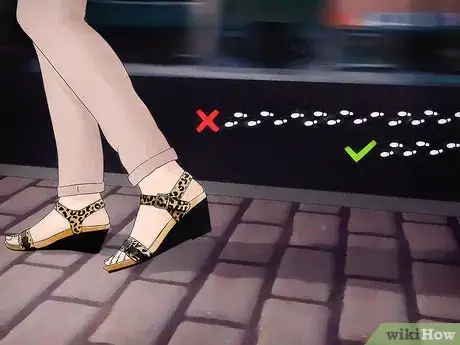
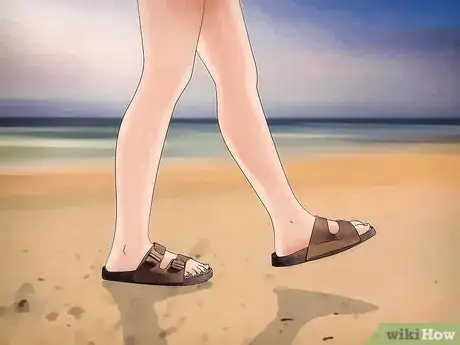
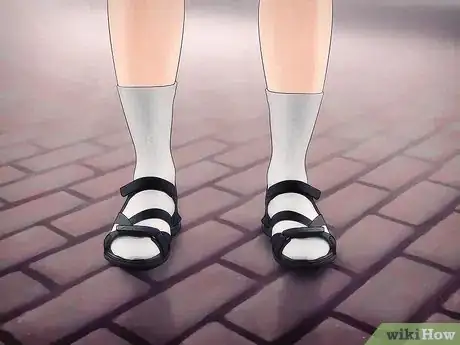
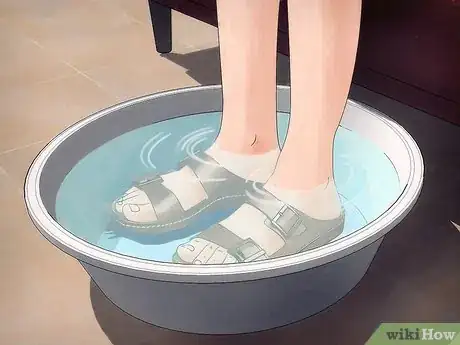
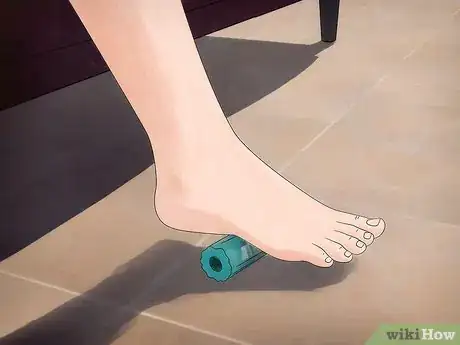
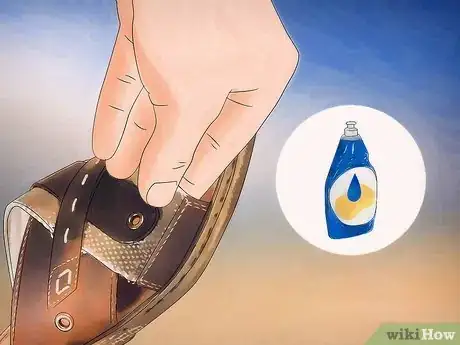
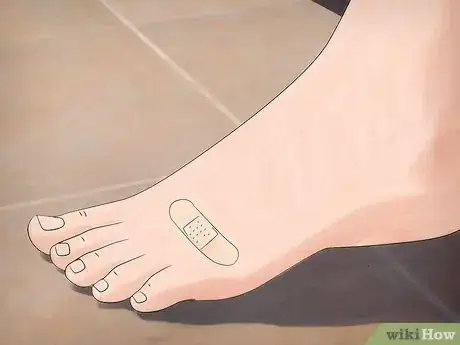
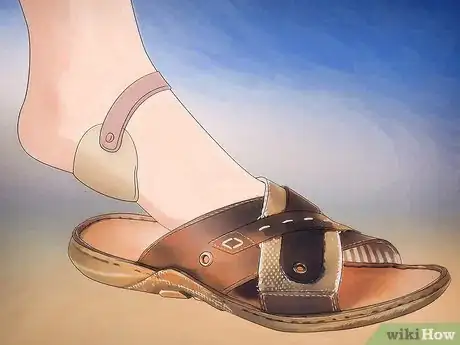

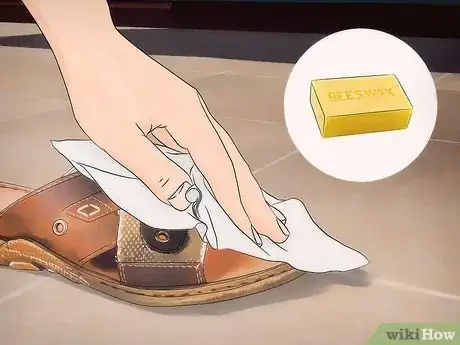
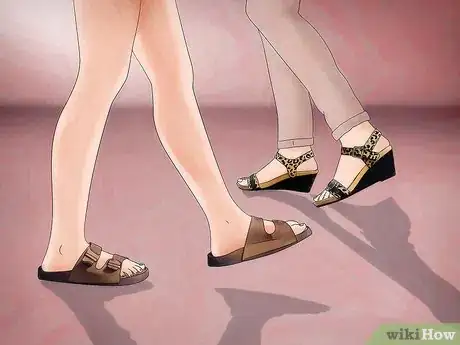

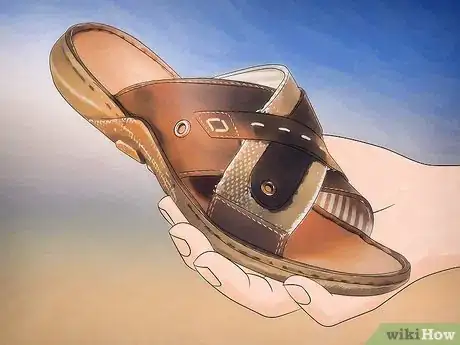
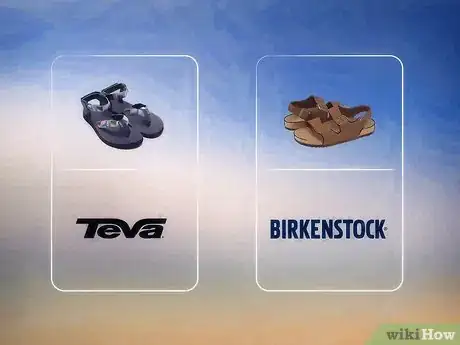
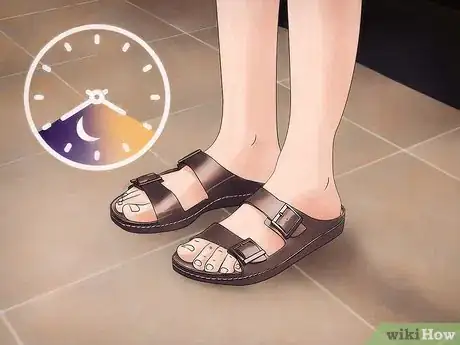
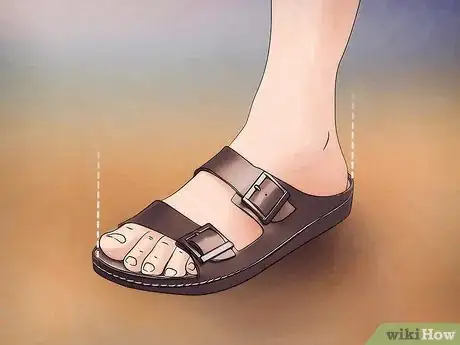

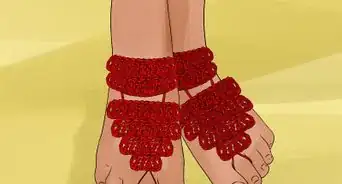
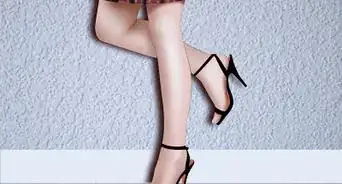
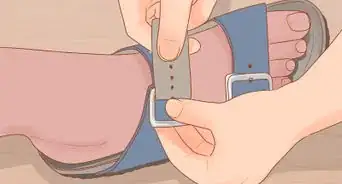
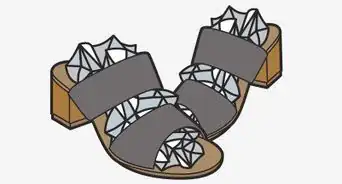
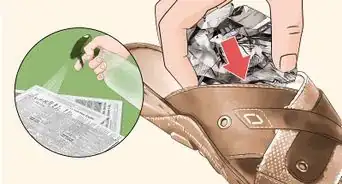
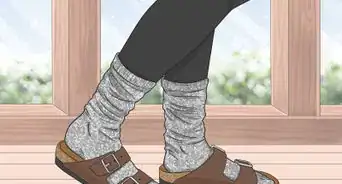
-Step-13.webp)
